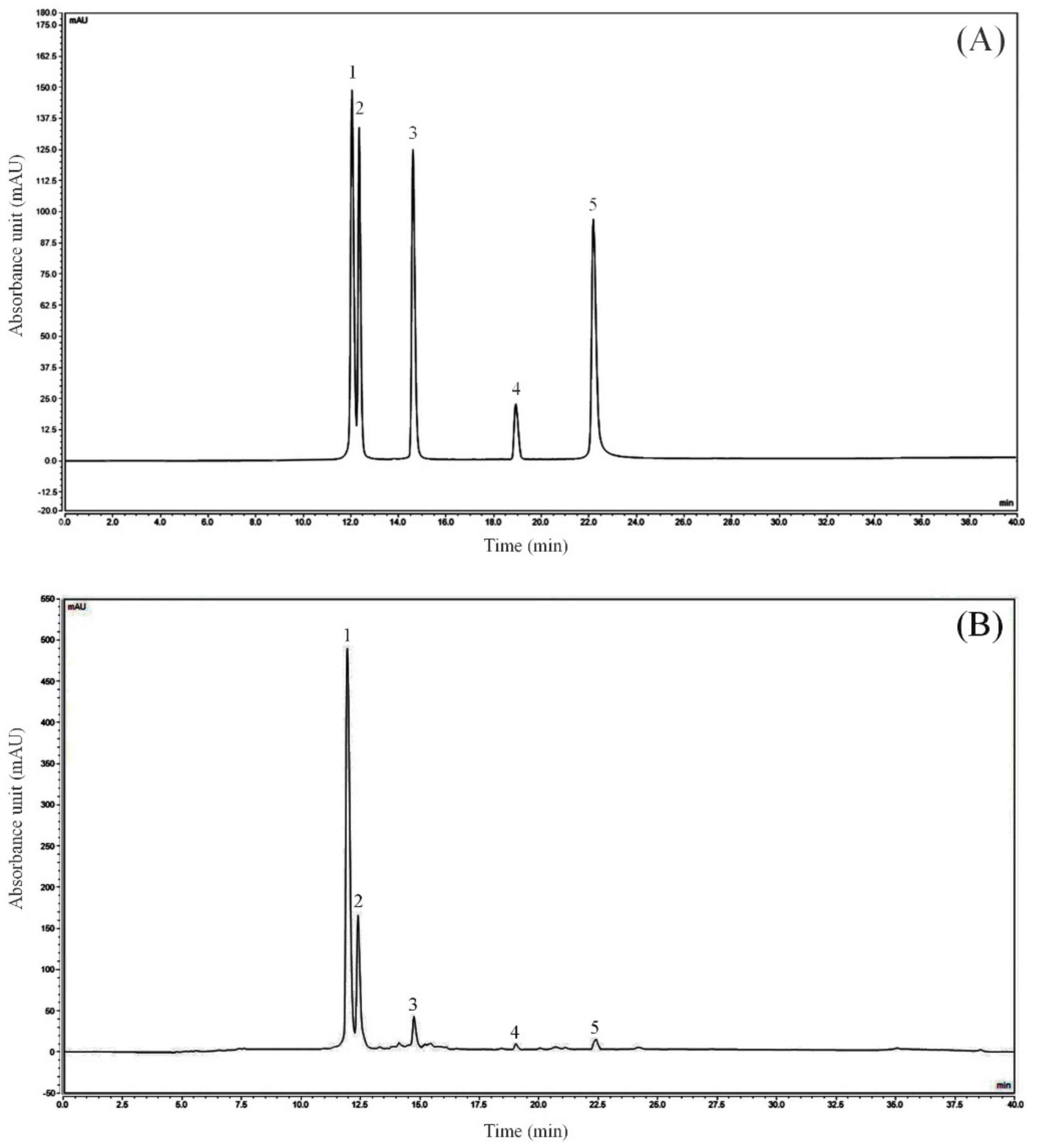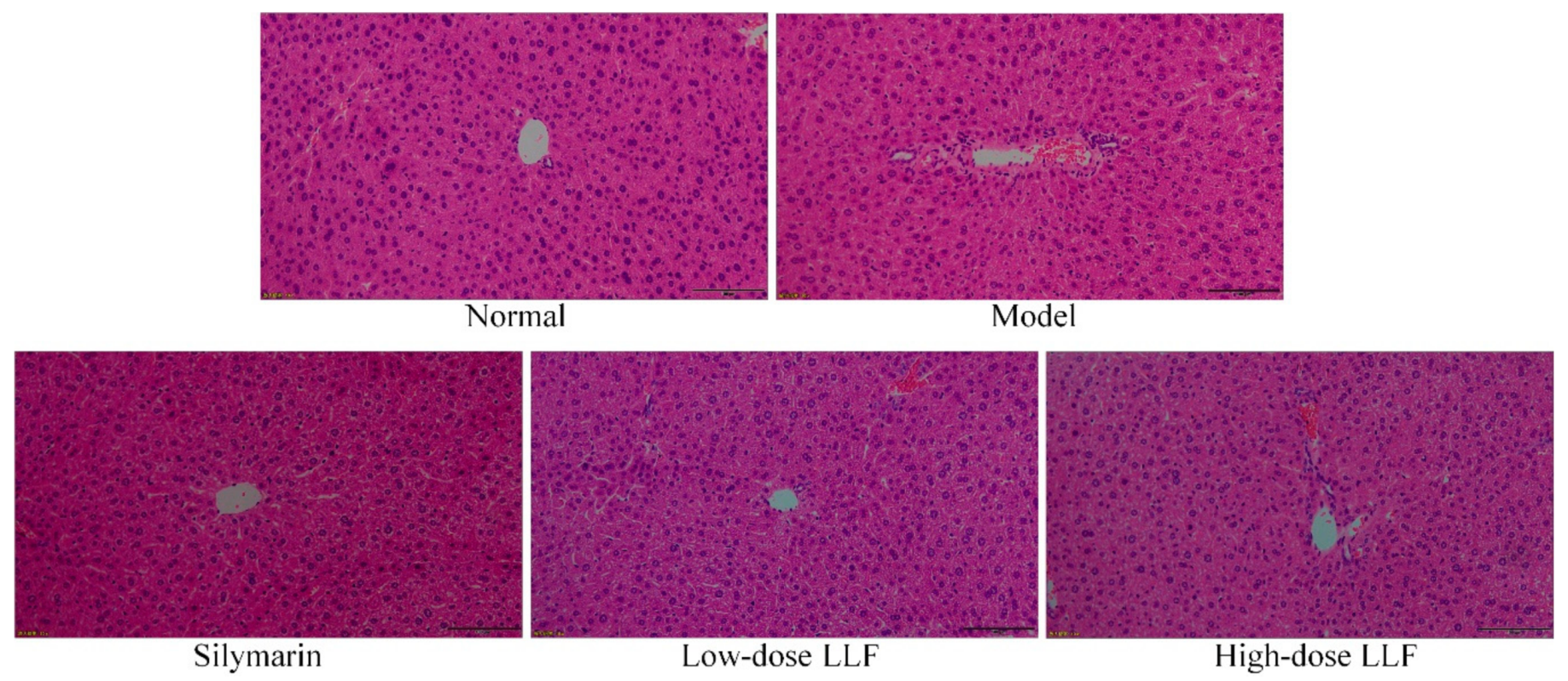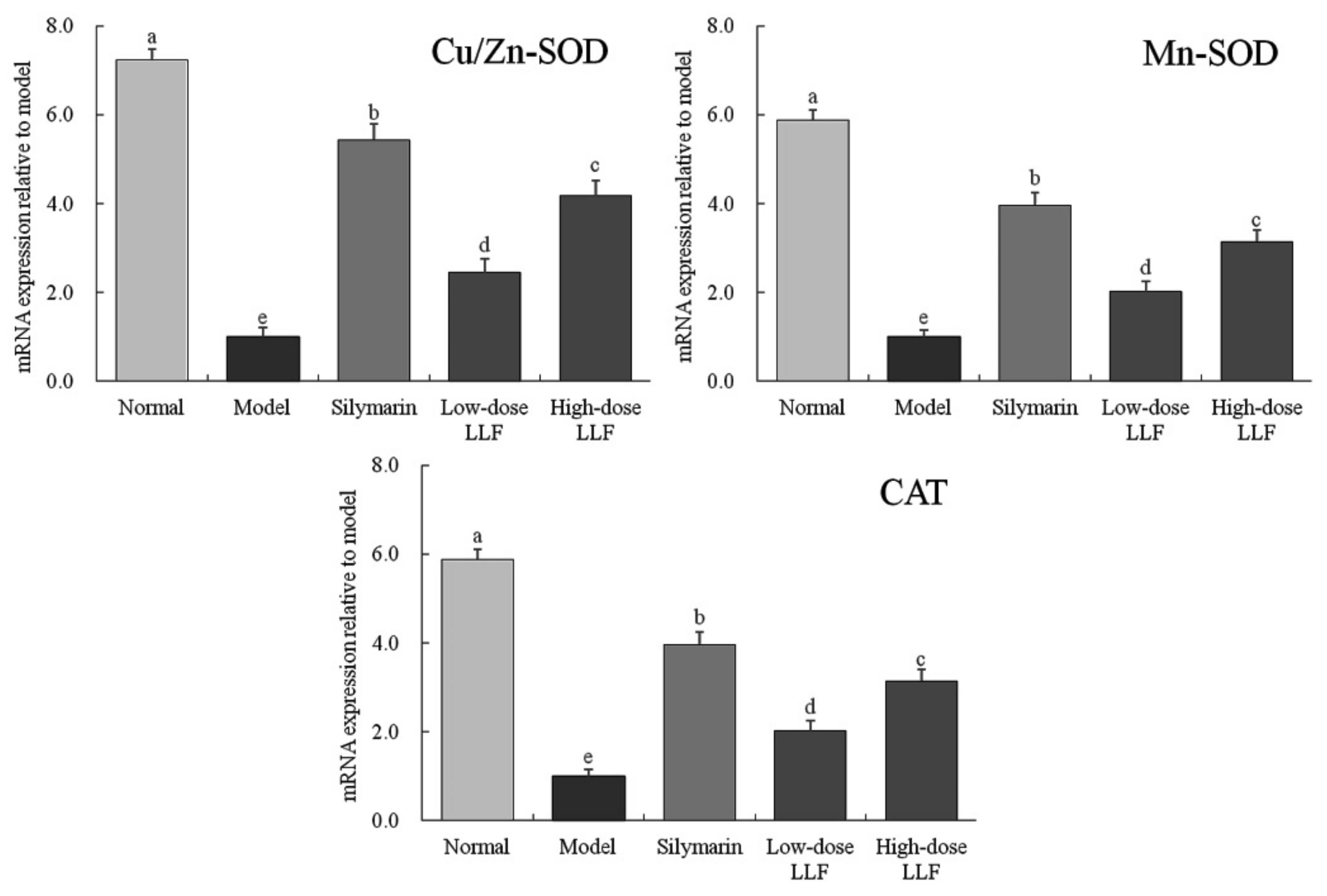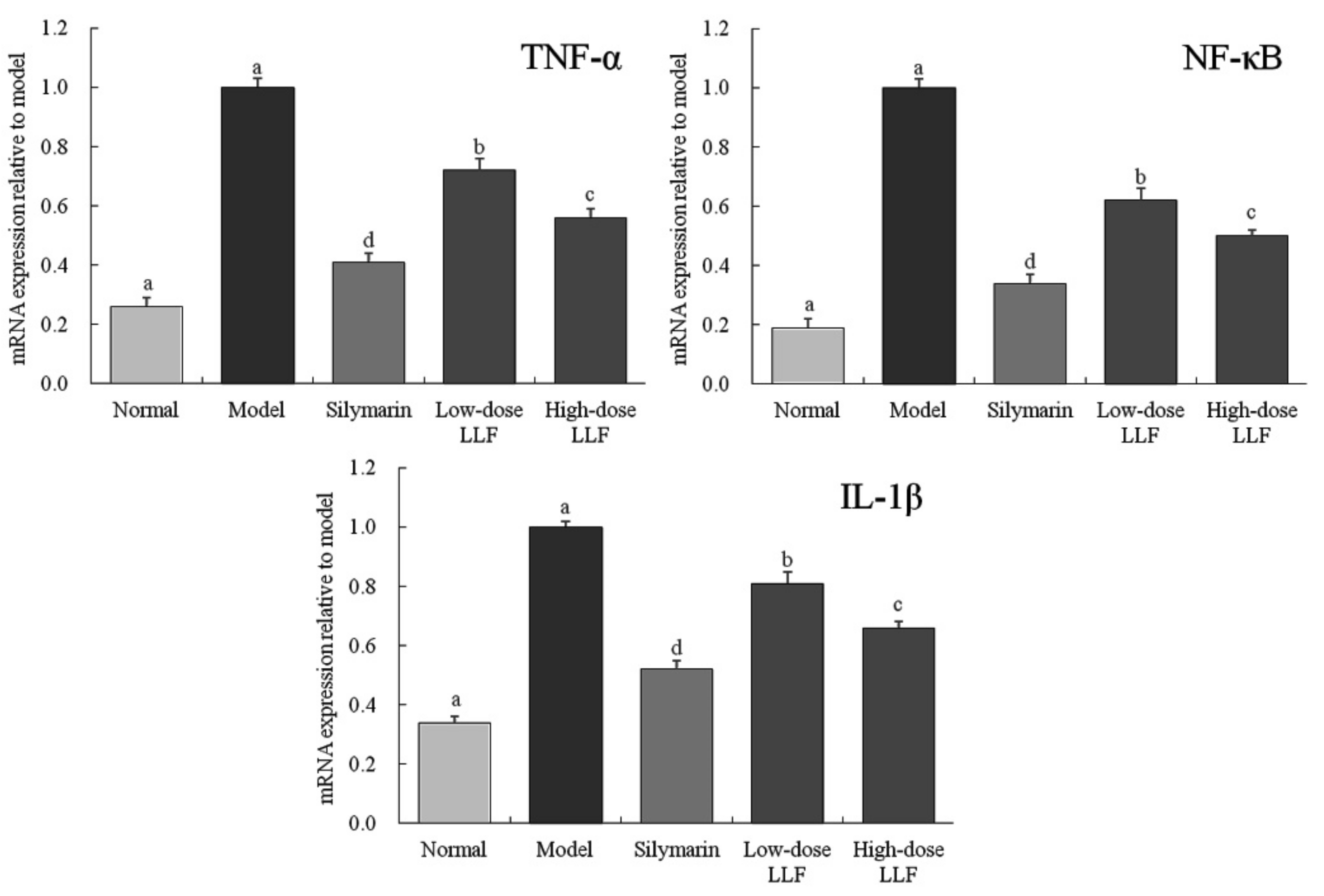Improvement Effect of Lotus Leaf Flavonoids on Carbon Tetrachloride-Induced Liver Injury in Mice
Abstract
1. Introduction
2. Experimental Section
2.1. Materials and Instruments
2.2. Extraction of Lotus Leaf Flavonoids (LLF)
2.3. Composition Analysis of Lotus Leaf Flavonoids (LLF)
2.4. Animal Experiment
2.5. Measurement of Serum Indices
2.6. Observation of Liver Histopathology
2.7. Measurement of mRNA Expression in the Liver by Quantitative Polymerase Chain Reaction (Q-PCR)
2.8. Measurement of Serum Indices
3. Results
3.1. Composition of Lotus Leaf Flavonoids (LLF)
3.2. Measurement of the Liver Index
3.3. Observation of Liver Histopathology
3.4. Measurement of Serum Indices
3.5. Expression Levels of Copper/Zinc Superoxide Dismutase (Cu/Zn-SOD), Manganese Superoxide Dismutase (Mn-SOD), and Catalase (CAT) in Liver Tissues
3.6. Expression Levels of Tumor Necrosis Factor-Alpha (TNF-α), Nuclear Factor Kappa B (NF-κB), and Interleukin-1β (IL-1β) in Liver Tissues
4. Discussion
5. Conclusions
Author Contributions
Funding
Conflicts of Interest
References
- Liu, B.; Li, J.; Yi, R.; Mu, J.; Zhou, X.; Zhao, X. Preventive effect of alkaloids from Lotus plumule on acute liver injury in mice. Foods 2019, 8, 36. [Google Scholar] [CrossRef] [PubMed]
- Yin, L.H.; Yu, H.; Peng, J.Y. Molecular Mechanism and Intervention of Chinese Medicine of Carbon Tetrachloride Induced Liver Injury. Chin. J. Mod. Appl. Pharm. 2015, 32, 1147–1155. [Google Scholar]
- Pan, Y.; Long, X.; Yi, R.; Zhao, X. Polyphenols in Liubao tea can prevent CCl4-induced hepatic damage in mice through its antioxidant capacities. Nutrients 2018, 10, 1280. [Google Scholar] [CrossRef]
- Tittarelli, R.; Pellegrini, M.; Scarpellini, M.G.; Marinelli, E.; Bruti, V.; di Luca, N.M.; Busardò, F.P.; Zaami, S. Hepatotoxicity of paracetamol and related fatalities. Eur. Rev. Med. Pharmacol. Sci. 2017, 21, 95–101. [Google Scholar] [PubMed]
- Chiew, A.L.; Domingo, G.; Buckley, N.A.; Stathakis, P.; Ress, K.; Roberts, D.M. Hepatotoxicity in a child following an accidental overdose of liquid paracetamol. Clin. Toxicol. 2020, 18, 1–4. [Google Scholar] [CrossRef]
- Zhu, M.; Liu, T.; Zhang, C.; Guo, M. Flavonoids of Lotus (Nelumbo nucifera) seed embryos and their antioxidant potential. J. Food Sci. 2017, 82, 1834–1841. [Google Scholar] [CrossRef]
- Zhu, Z.W.; Jin, H.Y.; Wu, Q.D. Effect of lotus leaf black tea on symptoms of patients with endogenous damp-heat syndrome. Shandong J. Tradi. Chin. Med. 2018, 37, 989–991. [Google Scholar]
- Santander-Borrego, M.; Taran, E.; Shadforth, A.M.; Whittaker, A.K.; Chirila, T.V.; Blakey, I. Hydrogels with Lotus leaf topography: Investigating surface properties and cell adhesion. Langmuir 2017, 33, 485–493. [Google Scholar] [CrossRef]
- Guo, Y.; Chen, X.; Qi, J.; Yu, B. Simultaneous qualitative and quantitative analysis of flavonoids and alkaloids from the leaves of Nelumbo nucifera Gaertn. using high-performance liquid chromatography with quadrupole time-of-flight mass spectrometry. J. Sep. Sci. 2016, 39, 2499–2507. [Google Scholar] [CrossRef]
- Li, F.; Sun, X.Y.; Li, X.W.; Yang, T.; Qi, L.W. Enrichment and separation of quercetin-3-O-β-d-glucuronide from lotus leaves (nelumbo nucifera gaertn.) and evaluation of its anti-inflammatory effect. J. Chromatogr. B Anal. Technol. Biomed. Life Sci. 2017, 1040, 186–191. [Google Scholar] [CrossRef]
- Watson, G.S.; Gellender, M.; Watson, J.A. Self-propulsion of dew drops on lotus leaves: A potential mechanism for self cleaning. Biofouling 2014, 30, 427–434. [Google Scholar] [CrossRef]
- Ye, D.Q.; Ding, Y.M.; Zhou, M.Q.; Hu, Z.L.; Shen, Y. Inhibitory effects of flavone on gallstone formation and its mechanism in rabbits. Jiangxi Med. J. 2006, 41, 252–254. [Google Scholar]
- Zhang, S.B.; Xu, X.; Ma, S.C.; Tang, L.Q.; Jiang, Z.P.; Fan, W.M.; Chen, J.F.; Chang, G.N.; Yang, L.J. Water extract of the lotus leaf suppressed expression of monocyte chemoattractant protein-1 (MCP-1) and vascular cell adhesion molecule 1 (VCAM-1) induced by oxidized low density lipoprotein (Ox-LDL) in human umbilical vein endothelial cells. Chin. Arch. Tradi. Chin. Med. 2011, 29, 799–802. [Google Scholar]
- Xing, X.F.; Feng, X.Q.; Liu, W.H.; Zhao, R.; Huo, M.; Qi, A.F.; Liu, S.F.; Feng, R.Y. Review on research of lotus leaf’s pharmacological efects. Glob. Tradi. Chin. Med. 2016, 9, 115–118. [Google Scholar]
- Lin, H.Y.; Kuo, Y.H.; Lin, Y.L.; Chiang, W. Antioxidative effect and active components from leaves of Lotus (Nelumbo nucifera). J. Agric. Food Chem. 2009, 57, 6623–6629. [Google Scholar] [CrossRef] [PubMed]
- Li, C.; Tan, F.; Yang, J.; Yang, Y.; Gou, Y.; Li, S.; Zhao, X. Antioxidant effects of Apocynum venetum tea extracts on d-galactose-induced aging model in mice. Antioxidants 2019, 8, 381. [Google Scholar] [CrossRef] [PubMed]
- Zhang, J.; Lu, D.Y.; Yuan, Y.; Chen, J.X.; Yi, S.; Chen, B.S.; Zhao, X. Liubao Insect tea polyphenols prevent HCl/ethanol induced gastric damage through its antioxidant ability in mice. RSC Adv. 2020, 10, 4984–4995. [Google Scholar] [CrossRef]
- Yi, R.; Tan, F.; Liao, W.; Wang, Q.; Mu, J.; Zhou, X.; Yang, Z.; Zhao, X. Isolation and identification of Lactobacillus plantarum HFY05 from natural fermented yak yogurt and its effect on alcoholic liver injury in mice. Microorganisms 2019, 7, 530. [Google Scholar] [CrossRef]
- Féher, J.; Lengyel, G. Silymarin in the prevention and treatment of liver diseases and primary liver cancer. Curr. Pharm. Biotechnol. 2012, 13, 210–217. [Google Scholar] [CrossRef]
- Chen, Y.S.; Chen, Q.Z.; Wang, Z.J.; Hua, C. Anti-Inflammatory and hepatoprotective effects of ganoderma lucidum polysaccharides against carbon tetrachloride-induced liver injury in Kunming mice. Pharmacology 2019, 103, 143–150. [Google Scholar] [CrossRef]
- Zou, J.; Qi, F.; Ye, L.; Yao, S. Protective role of grape seed proanthocyanidins against CCl4 induced acute liver injury in mice. Med. Sci. Monit. 2016, 22, 880–889. [Google Scholar] [CrossRef] [PubMed]
- Yuan, L.P.; Chen, F.H.; Ling, L.; Dou, P.F.; Bo, H.; Zhong, M.M.; Xia, L.J. Protective effects of total flavonoids of Bidens pilosa L. (TFB) on animal liver injury and liver fibrosis. J. Ethnopharmacol. 2008, 116, 539–546. [Google Scholar] [CrossRef]
- Wang, M.; Niu, J.; Ou, L.; Deng, B.; Wang, Y.; Li, S. Zerumbone protects against carbon tetrachloride (CCl4)-induced acute liver injury in mice via inhibiting oxidative stress and the inflammatory response: Involving the TLR4/NF-κB/COX-2 pathway. Molecules 2019, 24, 1964. [Google Scholar] [CrossRef] [PubMed]
- Iweala, E.E.J.; Evbakhavbokun, W.O.; Maduagwu, E.N. Antioxidant and hepatoprotective effect of Cajanus cajan in N-nitrosodiethylamine-induced liver damage. Sci. Pharm. 2019, 87, 24. [Google Scholar] [CrossRef]
- Albasher, G.; Almeer, R.; Al-Otibi, F.O.; Al-Kubaisi, N.; Mahmoud, A.M. Ameliorative effect of Beta vulgaris root extract on chlorpyrifos-induced oxidative stress, inflammation and liver injury in rats. Biomolecules 2019, 9, 261. [Google Scholar] [CrossRef] [PubMed]
- Liu, Q.; Li, X.; Li, C.; Zheng, Y.; Wang, F.; Li, H.; Peng, G. 1-Deoxynojirimycin alleviates liver injury and improves hepatic glucose metabolism in db/db Mice. Molecules 2016, 21, 279. [Google Scholar] [CrossRef]
- Wang, R.; Yang, Z.; Zhang, J.; Mu, J.; Zhou, X.; Zhao, X. Liver injury induced by carbon tetrachloride in mice is prevented by the antioxidant capacity of Anji White tea polyphenols. Antioxidants 2019, 8, 64. [Google Scholar] [CrossRef]
- Lin, H.I.; Wang, D.; Leu, F.J.; Chen, C.F.; Chen, H.I. Ischemia and reperfusion of liver induces eNOS and iNOS expression: Effects of a NO donor and NOS inhibitor. Chin. J. Physiol. 2004, 47, 121–127. [Google Scholar]
- Kanai, S.; Okano, H. Mechanism of the protective effects of sumac gall extract and gallic acid on the progression of CCl4-induced acute liver injury in rats. Am. J. Chin. Med. 1998, 26, 333–341. [Google Scholar] [CrossRef]
- Li, Y.G.; Ji, D.F.; Chen, S.; Hu, G.Y. Protective effects of sericin protein on alcohol-mediated liver damage in mice. Alcohol Alcohol. 2008, 43, 246–253. [Google Scholar] [CrossRef]
- Zhou, H.C.; Wang, H.; Shi, K.; Li, J.M.; Zong, Y.; Du, R. Hepatoprotective effect of baicalein against acetaminophen-induced acute liver injury in mice. Molecules 2019, 24, 131. [Google Scholar] [CrossRef] [PubMed]
- Kobaek-Larsen, M.; Baatrup, G.; Notabi, M.K.; El-Houri, R.B.; Pipó-Ollé, E.; Christensen Arnspang, E.; Christensen, L.P. Dietary polyacetylenic oxylipins falcarinol and falcarindiol prevent inflammation and colorectal neoplastic transformation: A mechanistic and dose-response study in a rat model. Nutrients 2019, 11, 2223. [Google Scholar] [CrossRef] [PubMed]
- Rusciano, M.R.; Sommariva, E.; Douin-Echinard, V.; Ciccarelli, M.; Poggio, P.; Maione, A.S. CaMKII activity in the inflammatory response of cardiac diseases. Int. J. Mol. Sci. 2019, 20, 4374. [Google Scholar] [CrossRef]
- Luedde, T.; Schwabe, R.F. NF-κB in the liver—linking injury, fibrosis and hepatocellular carcinoma. Nat. Rev. Gastroenterol. Hepatol. 2011, 8, 108–118. [Google Scholar] [CrossRef] [PubMed]
- Ilyas, G.; Zhao, E.; Liu, K.; Lin, Y.; Tesfa, L.; Tanaka, K.E.; Czaja, M.J. Macrophage autophagy limits acute toxic liver injury in mice through down regulation of interleukin-1β. J. Hepatol. 2016, 64, 118–127. [Google Scholar] [CrossRef] [PubMed]
- Jiang, W.; Wang, R.; Liu, D.; Zuo, M.; Zhao, C.; Zhang, T.; Li, W. Protective effects of kaempferitrin on advanced glycation end products induce mesangial cell apoptosis and oxidative stress. Int. J. Mol. Sci. 2018, 19, 3334. [Google Scholar] [CrossRef] [PubMed]
- Liu, B.; Tu, Y.; He, W.; Liu, Y.; Wu, W.; Fang, Q.; Tang, H.; Tang, R.; Wan, Z.; Sun, W.; et al. Hyperoside attenuates renal aging and injury induced by D-galactose via inhibiting AMPK-ULK1 signaling-mediated autophagy. Aging 2018, 10, 4197–4212. [Google Scholar] [CrossRef]
- Li, C.; Hu, M.; Jiang, S.; Liang, Z.; Wang, J.; Liu, Z.; Wang, H.-M.D.; Kang, W. Evaluation procoagulant activity and mechanism of astragalin. Molecules 2020, 25, 177. [Google Scholar] [CrossRef]
- Niederberger, K.E.; Tennant, D.R.; Bellion, P. Dietary intake of phloridzin from natural occurrence in foods. Br. J. Nutr. 2020, 8, 1–24. [Google Scholar] [CrossRef]
- Eid, H.M.; Haddad, P.S. The antidiabetic potential of quercetin: Underlying mechanisms. Curr. Med. Chem. 2017, 24, 355–364. [Google Scholar]
- Hazarika, A.F.; Ananya, K.A. Hepatoprotective and antioxidant properties in Nelumbo nucifera (lotus)-a review. Int. J. Pharm. Sci. Rev. Res. 2016, 39, 19–25. [Google Scholar]
- Yuan, L.; Gu, X.; Yin, Z.; Kang, W. Antioxidant activities in vitro and hepatoprotective effects of Nelumbo nucifera leaves in vivo. Afr. J. Tradit. Complement. Altern. Med. 2014, 11, 85–91. [Google Scholar] [CrossRef] [PubMed]
- Lee, D.B.; Kim, D.F.; Je, J.Y. Antioxidant and cytoprotective effects of lotus (Nelumbo nucifera) leaves phenolic fraction. Prev. Nutr. Food Sci. 2015, 20, 22–28. [Google Scholar] [CrossRef] [PubMed]
- Huang, B.; Ban, X.Q.; He, J.S.; Tong, J.; Tian, J.; Wang, Y.W. Hepatoprotective and antioxidant activity of ethanolic extracts of edible lotus (Nelumbo nucifera Gaertn.) leaves. Food Chem. 2010, 120, 873–878. [Google Scholar] [CrossRef]




| Time (min) | Current Speed (mL/min) | %A | %B |
|---|---|---|---|
| −10.000 | 0.500 | 88.0 | 12.0 |
| 0.000 | 0.500 | 88.0 | 12.0 |
| 30.000 | 0.500 | 60.0 | 40.0 |
| 35.000 | 0.500 | 0.0 | 100.0 |
| 40.000 | 0.500 | 0.0 | 100.0 |
| Gene Name | Sequence |
|---|---|
| Cu/Zn–SOD [17] | Forward: 5′–AACCAGTTGTGTTGTCAGGAC–3′ |
| Reverse: 5′–CCACCATGTTTCTTAGAGTGAGG–3′ | |
| Mn–SOD [17] | Forward: 5’-CAGACCTGCCTTACGACTATGG-3’ |
| Reverse: 5’-CTCGGTGGCGTTGAGATTGTT-3’ | |
| CAT [17] | Forward: 5’-GGAGGCGGGAACCCAATAG-3’ |
| Reverse: 5’-GTGTGCCATCTCGTCAGTGAA-3’ | |
| TNF-α [17] | Forward: 5’-GACCCTCAGACTCAGATCATCCTTCT-3’ |
| Reverse: 5’-ACGCTGGCTCAGCCACTC-3’ | |
| NF-κB [18] | Forward: 5′-GAGGCACGAGGCTCCTTTTCT-3′ |
| Reverse: 5′-GTAGCTGCATGGAGACTCGAACA-3′ | |
| IL-1β [17] | Forward: 5’-CTCCATGAGCTTTGTACAAGG-3’ |
| Reverse: 5’-TGCTGATGTACCAGTTGGGG-3’ | |
| GAPDH [17] | Forward: 5’-AGGTCGGTGTGAACGGATTTG-3’ |
| Reverse: 5’-GGGGTCGTTGATGGCAACA-3’ |
| Standard | Linear Regression Equation | R2 |
|---|---|---|
| Kaempferitrin | y = 8.1347 × + 3.7415 | 0.9844 |
| Hyperoside | y = 3.1862 × + 9.5029 | 0.9897 |
| Astragalin | y = 11.338 × + 0.8515 | 0.9994 |
| Phloridzin | y = 0.9844 × + 0.3039 | 0.9843 |
| Quercetin | y = 10.386 ×−3.0995 | 0.9990 |
| Chemical Compound | A(standard) (mAU) | A(LLF) (mAU) |
|---|---|---|
| Kaempferitrin | 18.8283 ± 0.0003 | 139.6697 ± 0.0001 |
| Hyperoside | 13.4423 ± 0.0004 | 32.7726 ± 0.0003 |
| Astragalin | 23.0850 ± 0.0003 | 1.1600 ± 0.0002 |
| Phloridzin | 2.2368 ± 0.0002 | 0.0452 ± 0.0003 |
| Quercetin | 17.7730 ± 0.0003 | 0.4064 ± 0.0003 |
| Compound | Kaempferitrin | Hyperoside | Astragalin | Phloridzin | Quercetin |
|---|---|---|---|---|---|
| Content (mg/g) | 397.85 ± 0.17 | 195.60 ± 0.15 | 10.34 ± 0.13 | 0.41 ± 0.03 | 4.73 ± 0.11 |
| Group | Body Weight (g) | Liver Weight (g) | Liver Index |
|---|---|---|---|
| Normal | 35.87 ± 1.36 a | 1.24 ± 0.16 c | 3.46 ± 0.26 d |
| Model | 35.14 ± 2.82 a | 2.41 ± 0.45 a | 6.86 ± 0.44 a |
| Silymarin | 35.51 ± 2.11 a | 1.58 ± 0.31 bc | 4.44 ± 0.27 c |
| Low-dose LLF | 35.66 ± 2.19 a | 2.10 ± 0.26 a | 5.89 ± 0.31 b |
| High-dose LLF | 35.91 ± 2.28 a | 1.71 ± 0.21 b | 4.76 ± 0.16 c |
| Group | ALT (U/L) | AST (U/L) | TG (mmol/L) | TC (mmol/L) |
|---|---|---|---|---|
| Normal | 12.05 ± 1.17 e | 10.83 ± 0.55 e | 0.36 ± 0.06 e | 1.51 ± 0.21 e |
| Model | 63.88 ± 4.10 a | 55.17 ± 3.28 a | 2.01 ± 0.16 a | 5.92 ± 0.42 a |
| Silymarin | 28.76 ± 2.06 d | 19.69 ± 2.13 d | 0.63 ± 0.06 d | 2.29 ± 0.28 d |
| Low-dose LLF | 47.82 ± 2.11 b | 40.55 ± 1.97 b | 1.35 ± 0.07 b | 4.03 ± 0.22 b |
| High-dose LLF | 34.18 ± 2.23 c | 26.82 ± 1.48 c | 0.86 ± 0.05 c | 3.14 ± 0.20 c |
© 2020 by the authors. Licensee MDPI, Basel, Switzerland. This article is an open access article distributed under the terms and conditions of the Creative Commons Attribution (CC BY) license (http://creativecommons.org/licenses/by/4.0/).
Share and Cite
Liu, T.; Tan, F.; Long, X.; Pan, Y.; Mu, J.; Zhou, X.; Yi, R.; Zhao, X. Improvement Effect of Lotus Leaf Flavonoids on Carbon Tetrachloride-Induced Liver Injury in Mice. Biomedicines 2020, 8, 41. https://doi.org/10.3390/biomedicines8020041
Liu T, Tan F, Long X, Pan Y, Mu J, Zhou X, Yi R, Zhao X. Improvement Effect of Lotus Leaf Flavonoids on Carbon Tetrachloride-Induced Liver Injury in Mice. Biomedicines. 2020; 8(2):41. https://doi.org/10.3390/biomedicines8020041
Chicago/Turabian StyleLiu, Tongji, Fang Tan, Xingyao Long, Yanni Pan, Jianfei Mu, Xianrong Zhou, Runkun Yi, and Xin Zhao. 2020. "Improvement Effect of Lotus Leaf Flavonoids on Carbon Tetrachloride-Induced Liver Injury in Mice" Biomedicines 8, no. 2: 41. https://doi.org/10.3390/biomedicines8020041
APA StyleLiu, T., Tan, F., Long, X., Pan, Y., Mu, J., Zhou, X., Yi, R., & Zhao, X. (2020). Improvement Effect of Lotus Leaf Flavonoids on Carbon Tetrachloride-Induced Liver Injury in Mice. Biomedicines, 8(2), 41. https://doi.org/10.3390/biomedicines8020041





